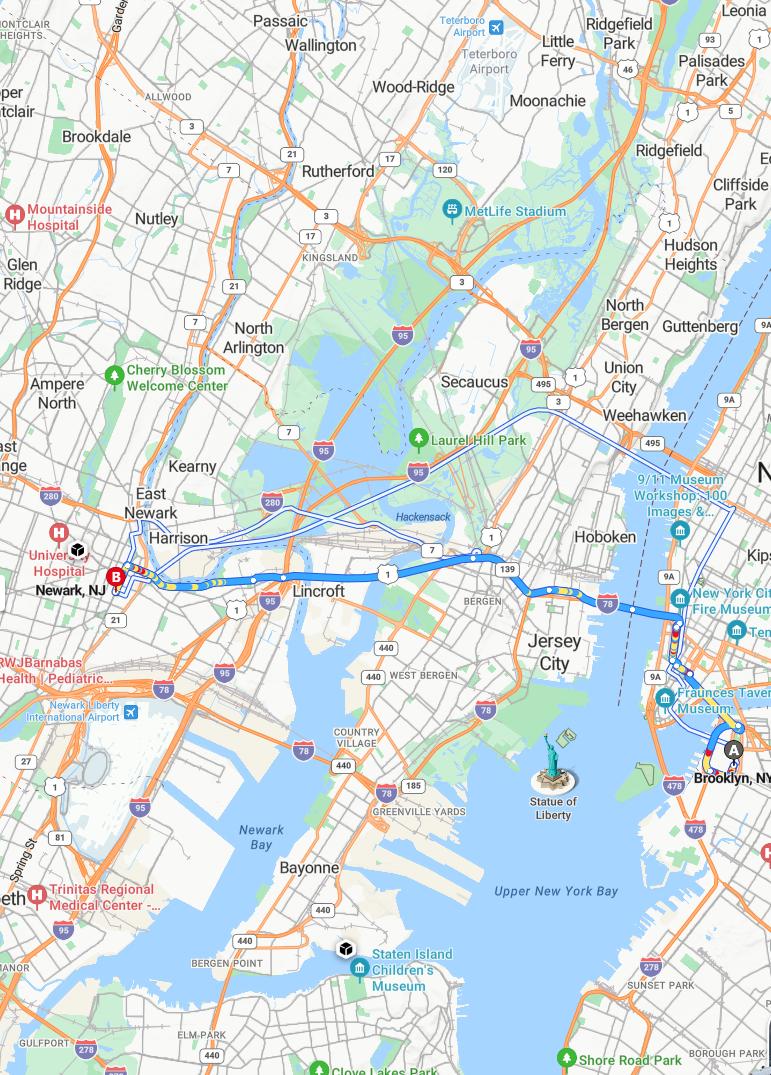Distance and estimated driving time
The drive from Brooklyn to Newark covers approximately 13.5 miles, primarily via I-78 W and Raymond Blvd. Under typical conditions, the journey takes around 42 minutes, making it a relatively quick trip between these two urban centers. Traffic patterns and time of day may influence the actual duration, so planning ahead can help optimize your commute. Overall, this route offers a convenient connection between Brooklyn and Newark, facilitating efficient travel across the New York-New Jersey region.
Driving route
The trip from Brooklyn to Newark offers a diverse journey through some of New York City's most iconic neighborhoods. Starting in Brooklyn, travelers pass through Brooklyn Heights before crossing into Manhattan, heading through vibrant areas like Kips Bay, Turtle Bay, Midtown East, and East Village. Along the way, the route continues through the Lower East Side, Chinatown, Civic Center, and the Financial District, showcasing a rich tapestry of cultural and historic landmarks. After exiting Manhattan, the journey proceeds through Bayonne and Elizabeth, culminating in the city of Newark, known for its urban innovation and vibrant communities. This route exemplifies the dynamic blend of historic sites and modern development that defines the New York City metropolitan area.

Traffic conditions and peak hours
Traffic conditions between Brooklyn and Newark can vary significantly depending on the time of day. During weekday rush hours, typically from 7:00 am to 10:00 am and 4:00 pm to 7:00 pm, congestion is usually heavy, especially around Manhattan neighborhoods like Midtown East, East Village, and the Financial District. On weekends or off-peak hours, the drive tends to be smoother, with less gridlock along areas such as Brooklyn Heights, Kips Bay, and Chinatown. Travelers should plan accordingly, allowing extra travel time during peak hours to avoid delays and ensure timely arrival at their destination.
Toll costs and payment methods
When driving from Brooklyn to Newark, travelers should be aware of toll costs along the route, which may include various bridges and tunnels such as the Manhattan Bridge and the Holland Tunnel. Tolls can vary depending on the time of day and the payment method selected, with cash payments traditionally accepted but increasingly replaced by electronic methods. Most drivers now prefer electronic toll collection systems like E-ZPass, which offer convenience and often reduce costs through discounted rates. It is advisable to ensure your E-ZPass account is funded before the trip to avoid delays and unexpected expenses at toll booths.
Parking options in Newark
Parking options in Newark are plentiful and varied, offering both on-street and off-street solutions to visitors. There are numerous public parking garages and lots located downtown and near popular destinations, providing convenient and secure options for short-term and long-term stays. Street parking is available in certain areas, although it can be competitive during peak hours, so paying close attention to parking regulations is essential. Additionally, many private parking facilities offer daily rates, making it easier for travelers driving from Brooklyn and surrounding areas to find suitable parking during their visit.
Alternative routes and detours
When traveling from Brooklyn to Newark, there are several alternative routes and detours to consider for avoiding traffic or exploring different neighborhoods. Drivers can take the Brooklyn-Queens Expressway (BQE), which offers a scenic route along the East River, or opt for the Verrazzano-Narrows Bridge to quickly cross into Staten Island before heading west. For detours, roads through Jersey City and Bayonne can provide additional options, especially during peak hours or closures. It's advisable to check real-time traffic updates and construction notices to choose the most efficient route and ensure a smooth journey.
Road safety tips and driving laws
When driving from Brooklyn to Newark, it's essential to prioritize road safety by following posted speed limits and avoiding distractions like mobile phones. Familiarize yourself with local driving laws, such as yielding to pedestrians at crosswalks and adhering to lane regulations, especially in busy areas like Midtown East and Chinatown. Ensure your vehicle is in good condition, with proper tire pressure and functioning lights, to prevent breakdowns or accidents. Finally, stay alert for sudden stops and heavy traffic in urban zones like the Financial District and Bayonne to ensure a safe journey.
Public transportation alternatives
Traveling from Brooklyn to Newark offers diverse public transportation options for convenient and efficient commuting. Passengers can utilize the NYC Subway, taking lines that connect Brooklyn neighborhoods to Manhattan and then transferring to NJ Transit or PATH trains at key transit hubs like World Trade Center or 33rd Street. Bus services such as NYC MTA routes or NJ Transit buses also provide direct connections between these areas, offering flexible scheduling. Additionally, ferry services operating from Brooklyn to locations near Newark can serve as scenic alternatives, enhancing the overall efficiency of your journey.
Scenic spots along the way
As you travel from Brooklyn to Newark, you'll encounter several scenic spots worth exploring. Starting in Brooklyn Heights, enjoy panoramic views of Manhattan's skyline from the historic Promenade, offering a picturesque start to your journey. Passing through Midtown East and Turtle Bay, take in the stunning architecture of notable landmarks like the United Nations Headquarters and Grand Central Station. As you approach Newark, consider visiting the scenic waterfront area along Bayonne, which provides beautiful river views, or the parks in Elizabeth for a relaxing break amidst lush greenery.
Vehicle maintenance tips for long drives
For long drives like the trip from Brooklyn to Newark, vehicle maintenance is essential to ensure safety and smooth travel. Before the journey, check tire pressure and tread depth to prevent blowouts and improve fuel efficiency. Additionally, inspect fluid levels such as oil, coolant, and brake fluid, and ensure all lights and signals are functioning properly. Regularly stopping for these checks can help identify potential issues early, minimizing the risk of breakdowns on the road.
